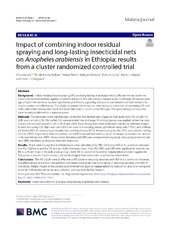| dc.contributor.author | Kenea, Oljira | en_US |
| dc.contributor.author | Balkew, Meshesha | en_US |
| dc.contributor.author | Tekie, Habte | en_US |
| dc.contributor.author | Deressa, Wakgari | en_US |
| dc.contributor.author | Loha, Eskindir | en_US |
| dc.contributor.author | Lindtjorn, Bernt | en_US |
| dc.contributor.author | Overgaard, Hans Jørgen | en_US |
| dc.date.accessioned | 2020-08-07T13:11:41Z | |
| dc.date.available | 2020-08-07T13:11:41Z | |
| dc.date.issued | 2019-05-24 | |
| dc.Published | Kenea O, Balkew M, Tekie H, Deressa W, Loha E, Lindtjorn B, Overgaard HJ. Impact of combining indoor residual spraying and long-lasting insecticidal nets on Anopheles arabiensis in Ethiopia: Results from a cluster randomized controlled trial. Malaria Journal. 2019;18:182 | eng |
| dc.identifier.issn | 1475-2875 | |
| dc.identifier.uri | https://hdl.handle.net/1956/23579 | |
| dc.description.abstract | Background: Indoor residual house spraying (IRS) and long-lasting insecticidal nets (LLINs) are the key front-line malaria vector interventions against Anopheles arabiensis, the sole primary malaria vector in Ethiopia. Universal cover- age of both interventions has been promoted and there is a growing demand in combinations of interventions for malaria control and elimination. This study compared the impact on entomological outcomes of combining IRS and LLINs with either intervention alone in Adami Tullu district, south-central Ethiopia. The epidemiological outcomes were recently published on a separate paper. Methods: This factorial, cluster-randomized, controlled trial randomized villages to four study arms: IRS + LLIN, IRS, LLIN, and control. LLINs (PermaNet 2.0) were provided free of charge. IRS with propoxur was applied before the main malaria transmission season in 2014, 2015 and 2016. Adult mosquitoes were collected in randomly selected villages in each arm using CDC light trap catch (LTC) set close to a sleeping person, pyrethrum spray catch (PSC), and artificial pit shelter (PIT), for measuring mosquito host-seeking density (HSD), indoor resting density (IRD), and outdoor resting density (ORD), respectively. Human landing catch (HLC) was performed in a sub-set of villages to monitor An. arabien- sis human biting rates (HBR). Mean vector densities and HBR were compared among study arms using incidence rate ratio (IRR) calculated by negative binomial regression. Results: There were no significant differences in mean densities (HSD, IRD, ORD) and HBR of An. arabiensis between the IRS + LLIN arm and the IRS arm (p > 0.05). However, mean HSD, IRD, ORD, and HBR were significantly lower in the IRS + LLIN arm than in the LLIN alone arm (p < 0.05). All An. arabiensis tested for malaria infection were negative for Plasmodium species. For this reason, the entomological inoculation rate could not be determined. Conclusions: The IRS + LLIN were as effective as IRS alone in reducing densities and HBR of An. arabiensis. However, the effectiveness of the two interventions combined was higher than LLINs alone in reducing densities and HBR of the vector. Added impact of the combination intervention against malaria infectivity rates of An. arabiensis compared to either intervention alone remains unknown and warrants further research. | en_US |
| dc.language.iso | eng | eng |
| dc.publisher | BioMed Central | eng |
| dc.relation.uri | 10.1186/s12936-019-2811-1 | |
| dc.rights | Attribution CC BY | eng |
| dc.rights.uri | http://creativecommons.org/licenses/by/4.0/ | eng |
| dc.title | Impact of combining indoor residual spraying and long-lasting insecticidal nets on Anopheles arabiensis in Ethiopia: Results from a cluster randomized controlled trial | en_US |
| dc.type | Peer reviewed | |
| dc.type | Journal article | |
| dc.date.updated | 2020-01-10T11:48:34Z | |
| dc.description.version | publishedVersion | en_US |
| dc.rights.holder | Copyright 2019 The Authors | |
| dc.identifier.doi | https://doi.org/10.1186/s12936-019-2811-1 | |
| dc.identifier.cristin | 1709241 | |
| dc.source.journal | Malaria Journal | |
| dc.relation.project | Norges forskningsråd: 220544 | |

